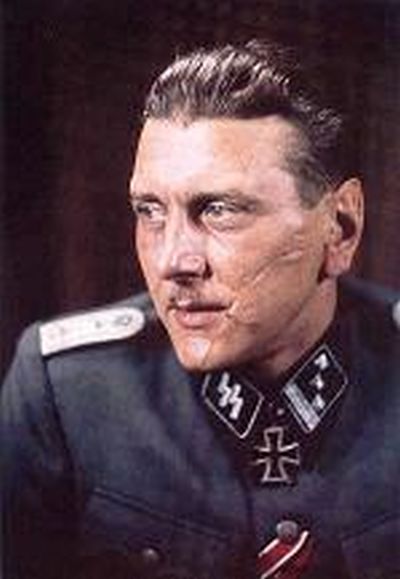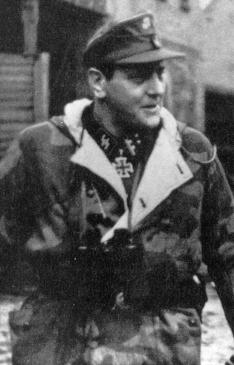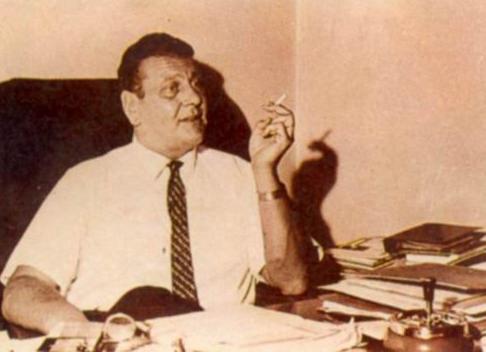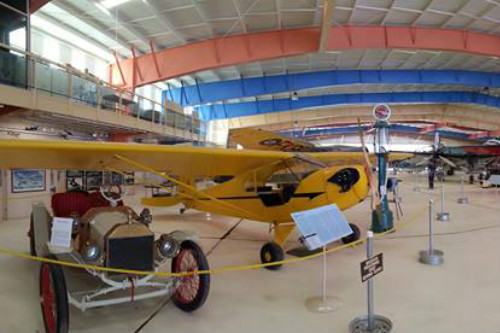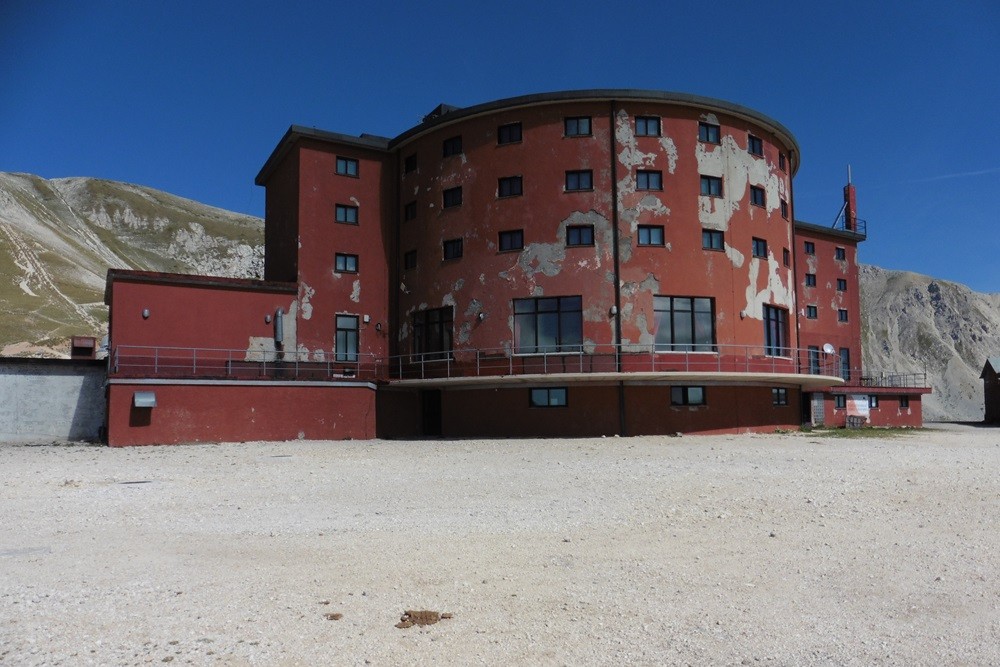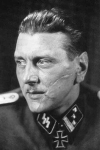Between Wahrheit und Dichtung (Truth and fiction)
Austrian Otto Skorzeny was born June 12, 1908 in Vienna to a middle class family that faced hardships during the years of crisis following the First World War. The name Skorzeny makes it likely his ancestors were of Slav origin. When Otto was 18 years of age and began to study engineering at Vienna University he became familiar with the traditional fencing associations. The art of fencing would earn Skorzeny his nickname Scarface later on. In one of the many duels, he received the "Schmisse" in his face, the honorable scars that were fiercely sought after among students as they were signs of traits of character like self discipline and courage.
When World War Two erupted, Austria, being part of the German Empire was obliged to deliver soldiers after the Anschluß. Yearning for action, Skorzeny did not wait to be called up. The 31-year-old engineer immediately joined the Luftwaffe as a volunteer. As he was considered too old, he reported to the Leibstandarte Adolf Hitler. After being transferred to the Waffen-SS Division Das Reich, Skorzeny would be part of the troops that invaded the Netherlands.
In quick succession, he took part in the invasion of France, the campaign on the Balkans, the advance into Romania and Bulgaria and subsequently the invasion of Russia in the summer of 1941. The Das Reich division operated everywhere in the frontlines during Operation Barbarossa. During the last massive offence in the winter of 1941, he was injured by shrapnel from a Katuscha or Stalin organ, the Soviet multiple rocket launcher. When he was transferred to Vienna in December, he did not only return with the Eisernes Kreuz – Iron Cross – but also with a serious head injury that would bother him for years to come.
Definitielijst
- Eisernes Kreuz
- Iron Cross. German military decoration.
- First World War
- Took place from 1914 till 1918 and is also named The Great War. The conflict started because of increased nationalism, militarism and neo-colonialism in Europe. Two alliances battled one another during the 4-year war, which after a dynamic start, resulted into static trench warfare. The belligerents were the Triple Alliance (consisting of Great-Britain, France, and Russia; later enlarged by Italy and the USA, amongst others) on the one hand and the Central Powers (consisting of Germany, Austria-Hungary, Bulgaria and the Ottoman empire) on the other hand. The war was characterized by the huge number of casualties and the use of many new weapons (flamethrowers, aircraft, poison gas, tanks). The war ended in 1918 when Germany and its allies surrendered unconditionally.
- invasion
- Armed incursion.
- Iron Cross
- English translation of the German decoration Eisernes Kreuz.
- Leibstandarte
- Elite troops, originally Hitler’s body guards. Starting as a motorized infantry regiment it grew into a Panzer division.
- Luftwaffe
- German air force.
- rocket
- A projectile propelled by a rearward facing series of explosions.
- Waffen-SS
- Name of Military section of the SS.
Images
Skorzeny’s special missions
Hitler’s stuntman
Early 1942, Skorzeny was made responsible for technical maintenance in the depot of the Leibstandarte in Berlin where he was tasked with converting the 1. SS-Division into a fully equipped armored division. One day he was informed the RSHA – Reichssicherheitshauptamt or Main Office of State Security – had selected him for commando actions behind the front. Skorzeny was put in command of Germany’s special units, the Friedenthaler Jagdverbände, named after Friedenthal near Berlin, their training ground. Skorzeny distinguished himself and his men for the first time by the spectacular rescue action of Mussolini (Bio Mussolini) on the Gran Sasso after he had been brought down by the Badoglio government on July 25, 1943.
Skorzeny managed to find out that Mussolini was kept prisoner in a ski hotel in the Abruzzen mountains. Parachutists and Skorzeny’s SS men landed in gliders in front of the hotel and managed to free Il Duce. That same day he was awarded the Ritterkreuz – Knight’s Cross – by Hitler personally and he was promoted to SS-Sturmbannführer. After the plan to capture Maréchal Pétain was abandoned Skorzeny was charged with capturing the Yugoslav partisan leader Tito. Tito managed to escape however because a German corps commander refused to cooperate with Skorzeny. He was also involved in the bloody revenge the Nazis launched against the conspirators involved in the attempt on Hitler on July 20, 1944, initiated by Claus Schenk Graf von Stauffenberg (Bio Von Stauffenberg).
In 1944, Skorzeny was to abduct the son of the Hungarian dictator Miklos Horthy in order to prevent the latter from signing a separate peace treaty with Stalin. This operation named Aktion Mickey Mouse also fitted Skorzeny like a glove. Skorzeny and his formation were to abduct the son of the Hungarian regent. The audacious action did not yield the desired result though. Skorzeny therefore decided to occupy the Burgberg, the hill on which Horthy’s palace was located. The occupation was successful, Horthy was forced to resign and was replaced by the pro-German general Szalasi. The armistice with the Soviet Union was revoked and Hungary remained an ally of Germany for the remainder of the war.
Skorzeny and the Trojan horse
Just before Christmas 1944, Hitler made a last desperate attempt to defeat the advancing Allied units. The outcome of what is known today as the Ardennes offensive, led to the German defeat in the west. Aktion Greif consisted of two separate actions. The first was the capture of three bridges across the river Meuse, a task entrusted to the 150 Panzerbrigade, equipped with American and British material like tanks and guns. The second action, creating chaos behind the Allied lines was entrusted to small groups of commandos; each time four commandos in jeeps who not only gathered and passed on information about vital enemy installations but also did everything in their power to create panic among the enemy. They achieved this by altering road signs, disrupting communication and relocating signs warning of mine fields. Each jeep crew consisted of one man who was fluent in English while the other three spoke the language rather well.
When the offensive was launched, Skorzeny and his men gradually penetrated the lines. He had a total of 150 commandos at his disposal, distributed among the attacking divisions of 6. Panzerarmee commanded by Sepp Dietrich (Bio Dietrich). As a number of Dietrich’s units failed to achieve a break through, many of them never saw action. Skorzeny himself was injured five days from the start of the offensive. The importance of Operation Greif cannot be overestimated from the viewpoint of the inevitable failure of the offensive. Fears ran high though. Infiltration into the American lines caused so much mayhem, even General Eisenhower (Bio Eisenhower) found himself a prisoner in his own quarters for some time.
As the war situation gradually deteriorated, Skorzeny played his part in the program of Hitler’s Vergeltungswaffen – revenge weapons. Along with Hanna Reitsch and Heinrich Lange, he was involved in an experiment with suicide missions with manned V-1s.
Skorzeny’s final battle
Skorzeny’s last remarkable feat of arms was the defense of the bridgehead near the medieval city of Schwedt on the river Oder. Heinrich Himmler (Bio Himmler) who in the meantime had risen to commander of the Ersatzheer (reserve army) and Heeresgruppe Weichsel (army group) charged Skorzeny with the impossible task in this late stage of the war, to stop the Soviets on the banks of the Oder. To him, this order meant a return to regular warfare since it did not entail a commando action. This task was a serious test of his powers of improvisation. Skorzeny managed to scrape a division together but his troops were short of weapons and had too little battle experience. The Schwedt Division held out for a month. The division consisted of Norwegian, Danish, Dutch, Belgian and French military personnel and even Russians. Later on Skorzeny was ordered to demolish the bridge across the Rhine at Remagen but his frogmen failed because of the chilly water.
Skorzeny’s last task in the war entailed forming an Alpenlandkorps. In May 1945, he retreated in to the Alps. From the fort in the Alps, located between the Totes Gebirge and the Dachstein mountain range the last ditch resistance would be organized. When the so-called Alpenfestung proved to exist only in the minds of a few fanatics, just like the Werwolf units, the fanatic Nazi partisans, there was nothing left other than to have himself arrested by the Americans. Although Skorzeny was acquitted in 1947 of the murder of American prisoners-of-war during the Ardennes offensive, (the Malmédy massacre), the American court martial kept him on its list of wanted persons. In 1948, Skorzeny managed to escape from the deNazification camp in Darmstadt.
Definitielijst
- Alpenfestung
- Fortification in the Alps. The first development spotted by the Americans in 1944. The Americans feared a stronghold in the Alps as a last resort of the Nazis. The plan was covered in mystery. On the one hand the Alpenfestung might be the last SS stronghold which could lead to defeat of the Allied forces. Enormous arms depots were built and Nazi elite troops would be able to hide everywhere in the Alps and cause death and despair behind enemy lines, sometimes even in allied uniforms. This terrifying development was fed by German propaganda trying to lure the American forces towards the Alps and away from the Rhine. Although the British warned against this, the Americans decided to divide their forces and had them advance towards Berlin as well as the south. The Alpenfestung turned out, however, to be nothing but a spectre.
- Ardennes offensive
- Battle of the Bulge, “Von Rundstedt offensive“ or “die Wacht am Rhein“. Final large German offensive in the west from December 1944 through January 1945.
- deNazification
- Post war policy of the allies in Germany to punish Nazi war criminals and to remove known Nazis from positions of power or public service.
- Heeresgruppe
- The largest German ground formation and was directly subordinate to the OKH. Mainly consisting of a number of “Armeen” with few directly subordinate other units. A Heeresgruppe operated in a large area and could number several 100,000 men.
- Infiltration
- Quiet incursion into enemy lines prior to an attack.
- Leibstandarte
- Elite troops, originally Hitler’s body guards. Starting as a motorized infantry regiment it grew into a Panzer division.
- mine
- An object filled with explosives, equipped with detonator which is activated by either remote control or by colliding with the targeted object. Mines are intended to destroy of damage vehicles, aircrafts or vessels, or to injure, kill or otherwise putting staff out of action. It is also possible to deny enemy access of a specific area by laying mines.
- Nazi
- Abbreviation of a national socialist.
- offensive
- Attack on a smaller or larger scale.
- resistance
- Resistance against the enemy. Often also with armed resources.
- RSHA
- Reichssicherheitshauptamt. The central information and security service of the Third Reich.
- Soviet Union
- Soviet Russia, alternative name for the USSR.
Images
Skorzeny and the Odessa mystery
At the capitulation of the Third Reich, the SS became an army of outlaws. Many SS men were brought to trial as war criminals by the Allies and sentenced but countless others were able to flee to other countries. Many of them would have been assisted in their flight by Odessa (Organisation der ehemaligen SS-Angehörigen) or Organization of former SS members, the secret group of brothers of the SS, established by Otto Skorzeny intended to smuggle war criminals out of Germany. There are lots of myths and legends about this mysterious organization. Odessa has also been an inspiration for exciting novels and movies such as "The Odessa files" by Frederick Forsyth.
Nazi hunters and some historians are convinced that the escape of Nazi war criminals to foreign countries has been orchestrated by Odessa and that clerical authorities have played an active role in some cases. Up until today, there is also the presumption that the SS, long before the end of the war, had hoarded large amounts of money, gold and precious stones to finance the escape of its members to other countries. Protected by right wing dictatorships, the wanted war criminals created "German colonies" in South America, real pieces of Heimat in exile where they did not have to abandon their former ideals. A well known example is the right wing sanctuary of President Alfredo Stroessner in Paraguay.
Henchmen of the Nazi regime such as Joseph Mengele (Bio Mengele), Klaus Barbie, Eduard Roschmann, Walter Kutschmann, Erich Priepke and Ante Pavelic had forged passports and entry visas for Argentina at their disposal. Some of them were taken from one religious institution to the other, disguised as priests, until they could safely depart from Genoa, Switzerland or Madrid by boat or plane. Argentina was a favorite destination. Here, Juan Peron headed a military dictatorship between 1946 and 1965 and again from 1973 to 1974. During his regime, hundreds of war criminals and thousands of collaborators from France, Belgium, Croatia and Slovakia found a safe haven in Argentina.
Skorzeny also was the possible organizer of "Die Spinne" (spider) which housed high ranking Nazis in South-American countries via Spain and Italy. Early 1949, he arrived in Argentina himself. In 1950 he took residence in Madrid. Using the nickname Rolf Steinbauer he headed a company and became representative for various firms in the German Federal Republic. In Spain, Skorzeny enjoyed personal protection by Franco himself and so he could freely move about in Madrid. He maintained a friendly relationship with Léon Degrelle (Bio Degrelle) and others. For many years, he traveled back and forth between Buenos Aires and Madrid and sometimes his trips took him to Paris. He is said to have been on friendly terms with Argentinean president Juan Peron and his wife Evita.
According to Skorzeny’s biographer Glenn Infield, Odessa enabled Adolf Eichmann (Bo Eichmann), Franz Stangl (Bio Stangl), Joseph Mengele and fighter pilot Hanns Ulrich Rudel to flee to South-America. In 1953, Skorzeny is said to have assisted Nasser in establishing the Egyptian secret service. Yasser Arafat is also said to have taken military training with Skorzeny. Arafat was the cousin of the grand mufti of Jerusalem, Haj-Amin al-Husseini. The grand mufti was a follower of Hitler, advocated the Endlösung and recruited soldiers in the Balkans for a Muslim SS division.
During the 60s, Skorzeny is said to have worked for Mossad, the Israeli secret service. In the interest of Israeli security, the Jewish state would have employed a dedicated Nazi like Skorzeny because there was great fear for President Nasser’s Egyptian rocket program as he also had employed Nazis like Joachim Daumling, chief of the Egyptian police; Johann von Leers, chief of the Egyptian state press and Alois Brunner (Bio Brunner).
In the countries where former SS members had found shelter, a number of organizations used the name Odessa. In a document, it is argued that in South-America, Friedrich Schwendt stood at the head of the organization and Otto Skorzeny in Spain. Johann von Leers acted as an important contact in the Arab countries after he had converted to the Islam and renamed himself Omar Amin Johann von Leers.
Although Otto Skorzeny has been linked to Odessa time and again, evidence to the effect this organization was an international central network has never been found. There can be no doubt however something like an Odessa organization has indeed existed. It has never been proven however that an umbrella organization has ever existed. It is certain though that various aid and veterans organizations have existed after the war.
Odessa must therefore be seen as an all encompassing description of various regional groups, rather than as one entity with a clearly defined program. The real purpose of these various organizations like Odessa, the Spinne and Stille Hilfe (silent aid) was not the establishment of a Nazi international movement but rendering aid and support to evade arrest and to have the necessary means at hand in order to survive. It entailed things like forging identity papers, providing shelter and assistance to get members across borders. There may have been of course international meetings of former members of the SS and SD with impossibly far reaching ambitions. Whatever it is, as is often the case with myths, in the long run they tend to start leading their own lives. For instance in the 50s, journalistic concoctions made the Spandau prisoners go crazy. According to rumors at the time, Skorzeny would have attempted to liberate the prisoners in Spandau using two helicopters and a hundred men. At the same time, a coup would take place and a new government installed, headed by Karl Dönitz (Bio Dönitz). The danger posed by these clandestine organizations of former SS members is rather exaggerated. It may well be Allied intelligence services may have considered them for years as a potential nucleus of a rebirth of Nazism, seen from the paranoid spirit at the time.
Skorzeny passed away in Madrid in 1975, a successful businessman. The same year, his memoirs of the war, entitled "La guerre inconnue" (the unknown war) were posthumously published in France.
Apart from misplaced romantics of war, it can be argued that Skorzeny has evolved into an icon of irregular warfare from which lessons have been drawn for the post war period also. The importance of a man like Skorzeny lies in the political-military powers of invention on the battlefield casting doubt on the conventional military way of thinking. However, Skorzeny remains a dark figure of whom it cannot be determined what to put on his record and what not. There is nothing else to do than add question marks and annotations to parts of some conspiracy theories.
Definitielijst
- capitulation
- Agreement between fighting parties concerning the surrender of a country or an army.
- dictatorship
- A form of government where the power in a country is in the hands of one person, the dictator. Originally a Roman regime in case of an emergency where total power would rest with one person during six months in order to face a crisis.
- Endlösung
- Euphemistic term for the final solution the Nazis had in store for the “Jewish problem”. Eventually the Endlösung would get the form of annihilating the entire Jewish people in extermination camps.
- Nazi
- Abbreviation of a national socialist.
- Nazism
- Abbreviation of national socialism.
- Odessa
- Organisation of Former SS-members. Secret organization of and for former SS-members. Organised new identities and housing abroad after the war.
- rocket
- A projectile propelled by a rearward facing series of explosions.
Images
Information
- Translated by:
- Arnold Palthe
- Published on:
- 19-01-2025
- Feedback?
- Send it!
Related sights
Sources
- KERSHAW, I., Hitler - Vergelding 1936-1945, Het Spectrum, Utrecht, 2003.
- KNOPP, G., Hitlers moordenaars, Het Spectrum, Utrecht, 2004.
- Forsyth, F., Geheim dossier; Odessa, Bruna & Zoon, Utrecht/Antwerpen, 1973, (vert.)
- Lambrechts, J., De zwarte wieg, Irak, nazi's en neoconservatieven, Houtekiet, Antwerpen/Amsterdam, 2003
- Speer, A., Speer in Spandau, dagboeken, In den Toren, Baarn, 1976, (vert), p. 206
- Weiss, .H., Biographisches Lexikon zum Dritten Reich, Frankfurt, 1999
- Whiting, Ch., Skorzeny, de gevaarlijkste man van Europa, Standaard Uitgeverij, Antwerpen/Utrecht, 1975, (vert.)
